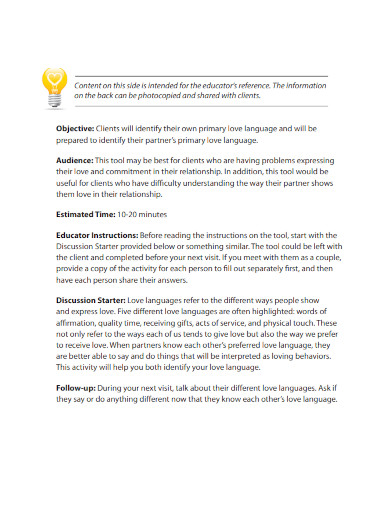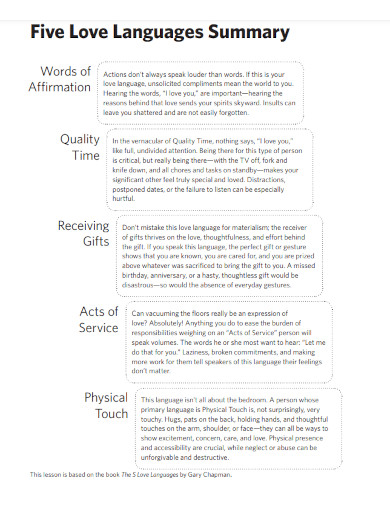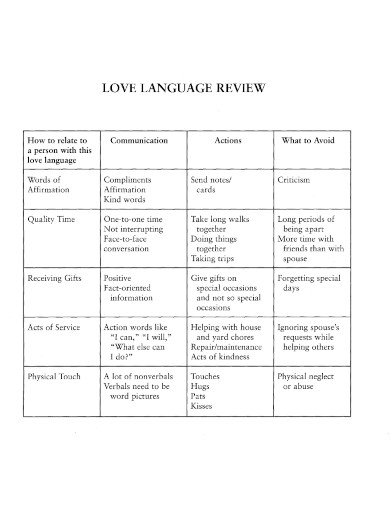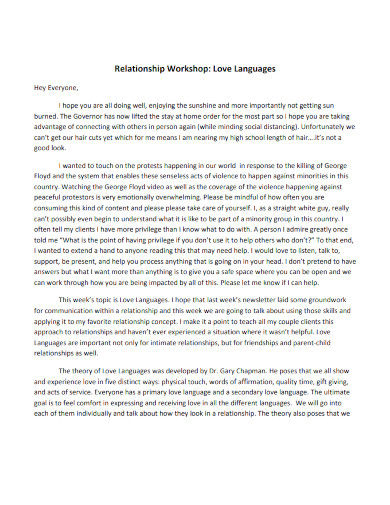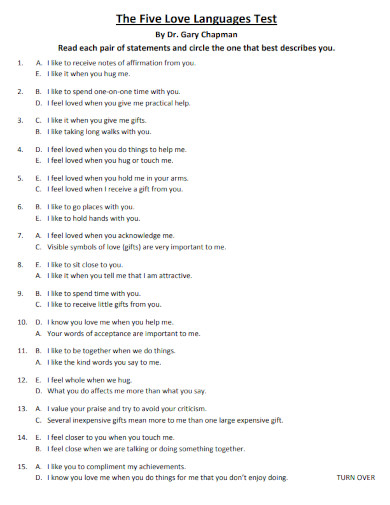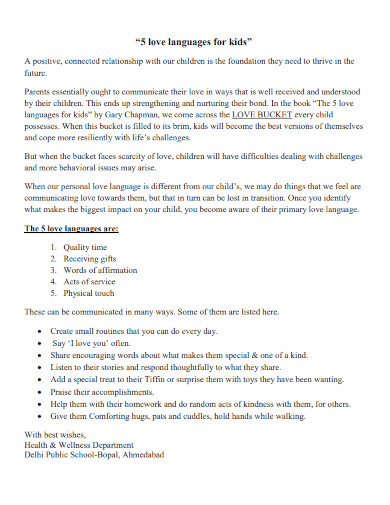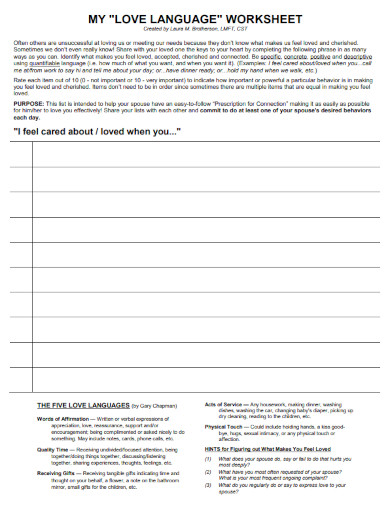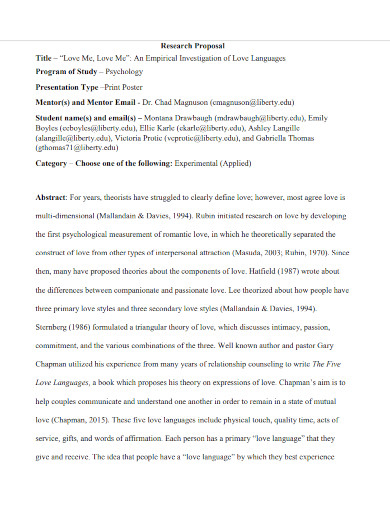50+ Love Language Examples
Understanding love languages can transform relationships by helping partners express and receive love in meaningful ways. Developed by Dr. Gary Chapman, the concept identifies five unique styles of communicating love: Words of Affirmation, Acts of Service, Receiving Gifts, Quality Time, and Physical Touch. Recognizing your own and your partner’s love language enhances emotional connection and deepens mutual understanding.
People express their love in various ways, each through different actions, words, and preferences. One of the most popular ideas about these preferences is referred to as love language.
What Is Love Language?
Love languages, developed by Dr. Gary Chapman, are five unique ways people express and experience love: Words of Affirmation, Acts of Service, Receiving Gifts, Quality Time, and Physical Touch. Understanding your own and your partner’s love language enhances emotional connection and deepens mutual understanding, transforming relationships by ensuring love is communicated in meaningful ways.
Types of Love Languages
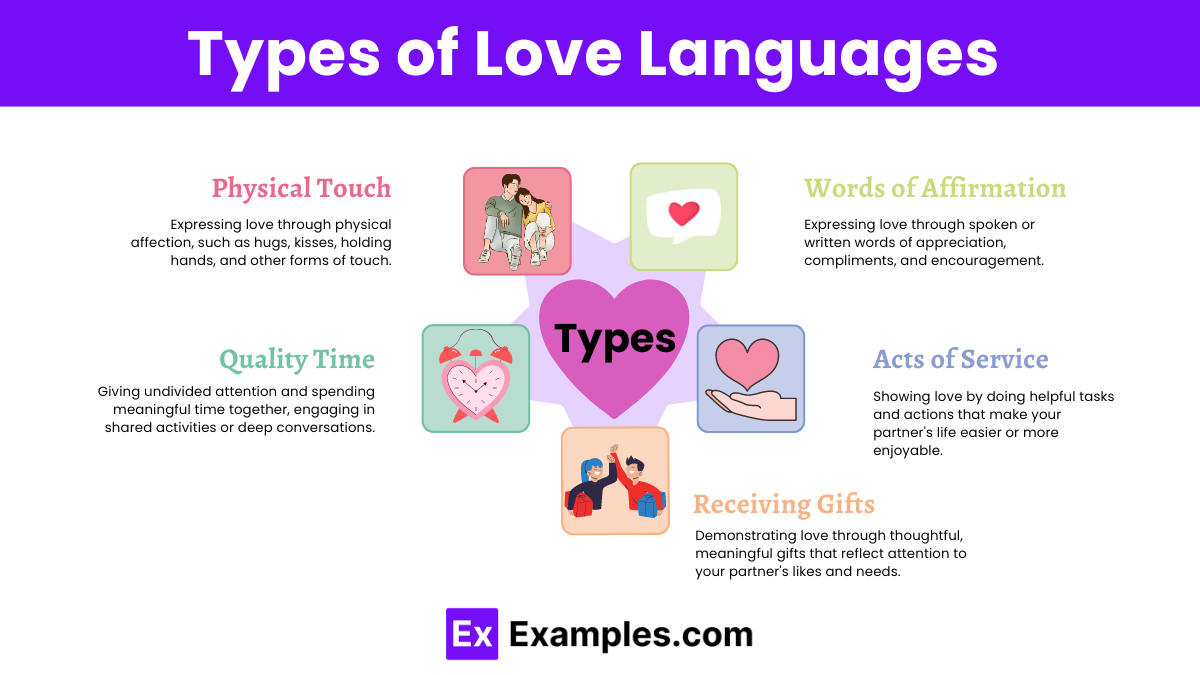
1. Words of Affirmation
This love language involves expressing love through words. It can include verbal compliments, words of appreciation, or kind, encouraging messages.
Examples:
- Saying “I love you” regularly.
- Writing a heartfelt note or letter.
- Complimenting your partner on their appearance or achievements.
2. Acts of Service
People who value acts of service feel loved when their partner does things to help them or make their life easier. Examples:
- Cooking a meal for your partner.
- Taking care of household chores without being asked.
- Running errands to save your partner time.
3. Receiving Gifts
For some, receiving thoughtful gifts is a clear sign of love. It’s not about the material value but the thought and effort behind the gift.
Examples:
- Surprising your partner with their favorite snack.
- Giving a meaningful, personalized gift.
- Celebrating special occasions with thoughtful presents.
4. Quality Time
Quality time is all about giving your partner your undivided attention and enjoying activities together.
Examples:
- Having a deep, uninterrupted conversation.
- Going on a walk or a hike together.
- Planning regular date nights.
5. Physical Touch
This love language involves expressing love through physical affection. It’s about feeling connected through touch.
Examples:
- Holding hands while walking.
- Giving hugs and kisses regularly.
- Cuddling on the couch while watching a movie.
Examples of Love Language
Love Language Examples in Relationships
Understanding and expressing love in relationships can be enhanced by recognizing the different love languages. Here are examples of each of the five love languages in relationships:
1. Words of Affirmation
Expressing love through spoken or written words to uplift and appreciate your partner.
- Compliments: “You look amazing in that outfit!”
- Appreciation: “Thank you for making dinner. It was delicious.”
- Encouragement: “I believe in you and know you’ll do great in your presentation.”
2. Acts of Service
Showing love by doing helpful things for your partner to make their life easier or more enjoyable.
- Household Tasks: Doing the laundry or cleaning the kitchen without being asked.
- Running Errands: Picking up groceries or handling other errands for your partner.
- Cooking: Preparing a favorite meal for your partner as a surprise.
3. Receiving Gifts
Giving thoughtful gifts that show you know and care about your partner’s preferences and interests.
- Special Occasions: Giving a meaningful gift on birthdays, anniversaries, or holidays.
- Just Because: Surprising your partner with flowers or a small gift for no special reason.
- Personalized Gifts: Creating a photo album of your memories together or a handmade item.
4. Quality Time
Spending meaningful time together and giving your undivided attention to your partner.
- Date Nights: Planning a special evening out or a cozy night in.
- Deep Conversations: Setting aside time to talk without distractions.
- Shared Activities: Engaging in hobbies or activities you both enjoy, like hiking or cooking together.
5. Physical Touch
Expressing love through physical affection to provide comfort and convey intimacy.
- Hugs and Kisses: Greeting each other with a hug or kiss when you come home.
- Holding Hands: Holding hands while walking or sitting together.
- Cuddling: Snuggling on the couch while watching a movie or before bed.
Love Language Examples of Acts of Service
Acts of Service is one of the five love languages, where love is expressed through actions that help and support your partner. Here are some examples of Acts of Service in relationships:
Household Chores
- Cleaning the House: Taking the initiative to vacuum, dust, and tidy up the living spaces.
- Doing the Laundry: Washing, drying, folding, and putting away clothes.
- Cooking Meals: Preparing breakfast, lunch, or dinner, especially when your partner has had a busy day.
- Washing Dishes: Taking care of the dishes after meals to give your partner a break.
Errands and Responsibilities
- Grocery Shopping: Picking up groceries so your partner doesn’t have to worry about it.
- Taking the Car for Service: Handling car maintenance tasks like oil changes, tire rotations, or refueling.
- Paying Bills: Managing household finances and paying bills on time.
- Running Errands: Picking up prescriptions, dropping off dry cleaning, or handling other errands.
Caring for Family
- Taking Care of Children: Watching the kids so your partner can have some time to themselves.
- Helping with Homework: Assisting children with their school assignments or projects.
- Planning Family Activities: Organizing outings, playdates, or family game nights.
Personal Care and Comfort
- Preparing a Relaxing Bath: Running a bath for your partner with candles and essential oils.
- Making Coffee: Preparing your partner’s favorite coffee in the morning.
- Packing Lunch: Packing a nutritious and delicious lunch for your partner to take to work.
- Giving a Massage: Offering a relaxing massage to help your partner unwind after a long day.
Supporting Personal Goals
- Helping with Projects: Assisting your partner with work or personal projects.
- Encouraging Breaks: Reminding your partner to take breaks and helping them manage their time effectively.
- Creating a Productive Environment: Setting up a clean, organized space for your partner to work or study.
Special Occasions
- Organizing Celebrations: Planning and organizing birthday parties, anniversaries, or special celebrations.
- Surprise Tasks: Completing a task your partner has been putting off or dreading.
Health and Wellbeing
- Preparing Healthy Meals: Cooking nutritious meals to support your partner’s health goals.
- Reminders: Setting reminders for appointments, medications, or important tasks.
Travel and Daily Commutes
- Driving: Offering to drive when your partner is tired or stressed.
- Packing: Helping your partner pack for trips, ensuring they have everything they need.
Maintaining the Home
- Yard Work: Mowing the lawn, gardening, or shoveling snow.
- Home Repairs: Fixing things around the house to keep everything in good working order.
Love Language Examples for Men
Understanding and expressing love through different love languages can enhance relationships. Here are examples of each love language, tailored specifically for men:
Words of Affirmation
- Verbal Praise: “You did an amazing job on that project at work!”
- Compliments: “You look really handsome today.”
- Appreciation: “Thank you for always being there for me.”
- Encouragement: “I believe in you and know you can achieve anything you set your mind to.”
Acts of Service
- Preparing Meals: Cooking his favorite meal after a long day.
- Helping with Chores: Taking care of household tasks like laundry, cleaning, or washing the car.
- Running Errands: Handling errands such as grocery shopping or picking up dry cleaning.
- Supporting Hobbies: Setting up his tools or equipment for his favorite hobby.
Receiving Gifts
- Thoughtful Gifts: Giving him something related to his interests, like a new gadget, a book by his favorite author, or sports memorabilia.
- Surprise Treats: Bringing home his favorite snack or drink.
- Experiences: Buying tickets to a concert, game, or event he’s excited about.
- Personalized Gifts: Creating a photo album of your memories together or a customized piece of art.
Quality Time
- Undivided Attention: Putting away distractions and spending focused time together, whether it’s talking or just being together.
- Shared Activities: Engaging in activities he enjoys, like hiking, playing sports, or watching movies.
- Date Nights: Planning a special evening out or a cozy night in.
- Weekend Getaways: Planning a short trip or adventure for just the two of you.
Physical Touch
- Hugs and Kisses: Greeting him with a hug and kiss when he comes home.
- Holding Hands: Holding hands while walking or sitting together.
- Cuddling: Snuggling on the couch while watching a movie or before bed.
- Massage: Giving him a relaxing massage after a stressful day.
Combining Love Languages
- Words and Touch: Telling him you love him while giving him a hug.
- Acts and Quality Time: Cooking a meal together and enjoying it while having a meaningful conversation.
- Gifts and Words: Giving him a thoughtful gift with a heartfelt note explaining why you chose it.
- Service and Touch: Helping him with a task and then relaxing together with physical affection.
Love Language Examples for Girls
Understanding and expressing love through different love languages can greatly enhance relationships. Here are examples of each love language, tailored specifically for girls:
Words of Affirmation
- Compliments: “You look beautiful today.”
- Appreciation: “Thank you for always being so supportive.”
- Encouragement: “You’re going to do great on your presentation. I believe in you.”
- Love Notes: Leaving a sweet note in her purse or sending a thoughtful text during the day.
Acts of Service
- Cooking for Her: Preparing her favorite meal or surprising her with breakfast in bed.
- Household Chores: Taking care of chores she dislikes, like doing the dishes or laundry.
- Errands: Running errands for her, such as picking up groceries or handling her dry cleaning.
- Car Maintenance: Taking her car for a wash, oil change, or filling up the gas tank.
Receiving Gifts
- Thoughtful Gifts: Giving her something meaningful, like jewelry, a book she’s been wanting, or a favorite perfume.
- Surprise Treats: Bringing home her favorite flowers, chocolates, or a coffee from her favorite café.
- Experiences: Planning a surprise date night, a weekend getaway, or tickets to a concert or show she wants to see.
- Personalized Gifts: Creating a scrapbook of your memories together or a custom piece of art.
Quality Time
- Undivided Attention: Spending time together without distractions, focusing solely on each other.
- Shared Activities: Doing activities she enjoys, such as hiking, cooking together, or watching her favorite movie.
- Date Nights: Planning regular date nights to keep the romance alive, whether it’s a fancy dinner or a cozy night in.
- Weekend Trips: Taking short trips to explore new places together.
Physical Touch
- Hugs and Kisses: Greeting her with a warm hug and kiss when you see her.
- Holding Hands: Holding hands while walking or sitting together.
- Cuddling: Snuggling on the couch while watching a movie or before going to sleep.
- Massage: Giving her a relaxing massage to help her unwind after a long day.
Combining Love Languages
- Words and Touch: Telling her you love her while giving her a gentle hug.
- Acts and Quality Time: Preparing a meal together and then enjoying it while having a meaningful conversation.
- Gifts and Words: Giving her a thoughtful gift accompanied by a heartfelt note explaining why you chose it.
- Service and Touch: Helping her with a task and then relaxing together with physical affection.
Love Language Examples of Quality Time
Quality Time is a love language that emphasizes giving someone your full attention and spending meaningful moments together. Here are examples of how to express love through Quality Time:
Daily Activities
- Meal Times: Have dinner together without distractions, focusing on conversation and connection.
- Morning Routine: Share a morning coffee or breakfast together, discussing your plans for the day.
- Evening Relaxation: Unwind together in the evening by sharing stories about your day.
Shared Hobbies
- Cooking Together: Prepare a meal together, trying new recipes or making favorite dishes.
- Exercise: Go for a run, take a fitness class, or do a workout routine together.
- Gardening: Spend time gardening, planting flowers, or growing vegetables together.
Special Outings
- Date Nights: Plan regular date nights, whether it’s a dinner out, a movie, or a new activity.
- Weekend Getaways: Take short trips to explore new places, visit nearby towns, or enjoy nature.
- Cultural Events: Attend concerts, theater performances, or art exhibits together.
Home Activities
- Game Nights: Play board games, card games, or video games together for a fun evening.
- Movie Marathons: Watch a series of movies or binge-watch a TV show you both enjoy.
- Reading Together: Read the same book and discuss it, or take turns reading aloud to each other.
Deep Conversations
- Heart-to-Heart Talks: Set aside time for meaningful conversations about dreams, goals, and feelings.
- Future Planning: Discuss and plan future vacations, projects, or life goals together.
- Listening Sessions: Simply listen to your partner talk about their day, concerns, or interests without interrupting.
Outdoor Activities
- Hiking: Go on hiking adventures to explore nature and enjoy each other’s company.
- Picnics: Pack a picnic and spend the day at a park or beach.
- Stargazing: Find a quiet spot to watch the stars and talk about life.
Creative Pursuits
- Crafting: Work on a DIY project or craft together, like painting, knitting, or building something.
- Music: Play musical instruments together, sing, or create a playlist of your favorite songs.
Special Traditions
- Anniversary Celebrations: Celebrate your anniversary by revisiting special places and reliving memories.
- Holiday Rituals: Establish and enjoy holiday traditions, like decorating for Christmas or carving pumpkins for Halloween.
- Daily Rituals: Create small daily rituals, like having a nightly tea or coffee before bed.
Simple Togetherness
- Relaxing: Simply sit together, whether it’s on the porch, by the fireplace, or in a cozy spot at home, enjoying each other’s presence.
- Mindfulness: Practice mindfulness or meditation together to connect on a deeper level.
Love Language Examples for Couples
Understanding and expressing love through different love languages can greatly enhance relationships for couples. Here are examples of each love language tailored specifically for couples:
Words of Affirmation
- Compliments: “You look amazing today.”
- Appreciation: “Thank you for always being there for me.”
- Encouragement: “I believe in you and know you can achieve anything you set your mind to.”
- Love Notes: Leaving a sweet note in your partner’s bag or sending a thoughtful text during the day.
Acts of Service
- Cooking Meals: Preparing breakfast, lunch, or dinner, especially when your partner has had a busy day.
- Household Chores: Taking care of chores like laundry, cleaning, or washing the car without being asked.
- Running Errands: Handling errands such as grocery shopping or picking up dry cleaning.
- Supporting Hobbies: Setting up your partner’s tools or equipment for their favorite hobby.
Receiving Gifts
- Thoughtful Gifts: Giving something meaningful related to your partner’s interests, like a new gadget, a book, or sports memorabilia.
- Surprise Treats: Bringing home your partner’s favorite snack, flowers, or a drink from their favorite café.
- Experiences: Planning a surprise date night, a weekend getaway, or tickets to a concert or show they’re excited about.
- Personalized Gifts: Creating a photo album of your memories together or a customized piece of art.
Quality Time
- Undivided Attention: Spending time together without distractions, focusing solely on each other.
- Shared Activities: Engaging in activities you both enjoy, like hiking, cooking together, or watching movies.
- Date Nights: Planning regular date nights to keep the romance alive, whether it’s a fancy dinner or a cozy night in.
- Weekend Trips: Taking short trips to explore new places together.
Physical Touch
- Hugs and Kisses: Greeting each other with a warm hug and kiss when you come home.
- Holding Hands: Holding hands while walking or sitting together.
- Cuddling: Snuggling on the couch while watching a movie or before bed.
- Massage: Giving your partner a relaxing massage to help them unwind after a long day.
Combining Love Languages
- Words and Touch: Telling your partner you love them while giving them a gentle hug.
- Acts and Quality Time: Preparing a meal together and then enjoying it while having a meaningful conversation.
- Gifts and Words: Giving your partner a thoughtful gift accompanied by a heartfelt note explaining why you chose it.
- Service and Touch: Helping your partner with a task and then relaxing together with physical affection.
Love Language in the Family Examples
Understanding and expressing love within a family through different love languages can strengthen bonds and enhance relationships. Here are examples of each love language tailored for family settings:
Words of Affirmation
- Praising Children: “You did a fantastic job on your homework!”
- Expressing Gratitude: “Thank you for helping set the table for dinner.”
- Encouraging Words: “I know you can do it. Keep trying!”
- Affectionate Nicknames: Using loving and positive nicknames for family members.
Acts of Service
- Helping with Homework: Assisting children with their school assignments.
- Preparing Meals: Cooking a special meal or favorite dish for family members.
- Household Chores: Cleaning, doing laundry, or organizing the house to make life easier for everyone.
- Running Errands: Taking care of errands like grocery shopping or picking up prescriptions.
Receiving Gifts
- Surprise Treats: Bringing home favorite snacks or small gifts for family members.
- Holiday and Birthday Gifts: Giving thoughtful presents that show you know and care about the recipient’s interests.
- Handmade Gifts: Creating personalized gifts, such as crafts or artwork.
- Special Occasions: Celebrating milestones with meaningful gifts.
Quality Time
- Family Game Nights: Playing board games or video games together.
- Weekend Outings: Planning trips to parks, museums, or other fun destinations.
- Shared Hobbies: Engaging in activities that everyone enjoys, like cooking, hiking, or gardening.
- Movie Nights: Watching favorite movies or TV shows together as a family.
Physical Touch
- Hugs and Kisses: Giving warm hugs and kisses to family members daily.
- Cuddling: Snuggling on the couch during movie nights or bedtime stories.
- Playful Touch: Engaging in playful activities like tickling or wrestling with kids.
- Holding Hands: Holding hands while walking or sitting together.
Combining Love Languages
- Words and Acts: Complimenting family members while helping them with a task.
- Gifts and Quality Time: Giving a family member a new game and playing it together.
- Service and Touch: Helping with a chore and giving a hug afterward as a thank you.
- Quality Time and Words: Spending one-on-one time with a family member and expressing how much you value that time together.
Words of Affirmation Love Language Examples
Words of Affirmation is a love language that involves expressing affection, appreciation, and encouragement through spoken or written words. Here are some examples tailored for different contexts:
In Romantic Relationships
- Compliments: “You look stunning tonight.”
- Appreciation: “I really appreciate all the hard work you put into making our home so beautiful.”
- Encouragement: “I believe in you and know you’ll do great at your presentation tomorrow.”
- Expressing Love: “I love you more every day.”
In Family Relationships
- Praising Children: “You did an amazing job on your project! I’m so proud of you.”
- Gratitude to Parents: “Thank you for always being there for me. Your support means the world to me.”
- Encouraging Siblings: “I know you can achieve your dreams. You’re so talented and determined.”
- Affirming Partners: “You are such a wonderful parent. Our children are lucky to have you.”
In Friendships
- Acknowledgment: “You’re such a great friend. I’m so grateful to have you in my life.”
- Support: “You’ve got this! I believe in your ability to overcome any challenge.”
- Compliments: “You always know how to make me laugh. You have such a great sense of humor.”
- Encouragement: “I know this is a tough time, but you’re strong and you’ll get through it.”
In Professional Relationships
- Appreciation: “Thank you for your hard work on this project. It’s really made a difference.”
- Acknowledgment: “Your insights during the meeting were invaluable. You always bring great ideas to the table.”
- Encouragement: “I’m confident in your ability to lead this initiative. You have all the skills needed to succeed.”
- Recognition: “You’ve been doing a fantastic job, and it hasn’t gone unnoticed.”
In Educational Settings
- To Students: “You’ve made incredible progress this semester. Keep up the great work!”
- To Teachers: “Thank you for your dedication and for always going the extra mile for your students.”
- To Classmates: “Your presentation was really impressive. You clearly put a lot of effort into it.”
- To Mentors: “Your guidance has been so helpful. I’m very grateful for your support and advice.”
General Affirmations
- Expressing Love: “I love and appreciate you more than words can say.”
- Positive Reinforcement: “You are capable of amazing things. Keep believing in yourself.”
- Gratitude: “Thank you for being such a positive influence in my life.”
- Affirmation: “You are valued and cherished. Your presence makes a difference.”
More Love Language Templates & Examples
1. Love Language Template
2. Five Love Languages Summary
3. Love Language Review
4. Love Languages Relationship Workshop
5. Love Languages Personal Profile
6. The Five Love Languages Test
7. Love Languages for Kids
8. Love Language Worksheet
9. An Empirical Investigation of Love Languages
How to Use Love Languages on The Person You Love
A person’s love language can determine the person’s expectations and preferences when receiving actions of affection. If you want to learn more about love languages, you may read any of the love language examples, love language samples, and articles above.
Step 1: Determine the Person’s Love Langauge
Begin by outlining and determining the person’s love language. You can ask or try to observe which love language they prefer.
Step 2: Practice Conveying the Chosen Love Language
Each love language has associated actions that will allow the person to express their affection, similar to that of an archetype. Be sure to practice conveying the actions related to or adjacent to the chosen love language. Note each type of love language has its facial expressions and body language.
Step 3: Apply the Love Language at the Appropriate Time
Each action should be properly applied at the appropriate time, as this will have a negative effect if improperly times. For example, one can send love letters or poems to their loved one while they are grieving the loss of another loved one, which is inappropriate.
Step 4: Note the Reaction of Your Loved One
Everyone reacts differently to each stimulus. This is why you should note the reaction of your loved one, as these actions may align with the person’s love language but is something the person does not like.
How to Identify Your Love Language
1. Reflect on Your Preferences
Think about what makes you feel most loved and appreciated. Consider past relationships and what actions or words made you feel the happiest and most valued.
2. Pay Attention to Your Requests
Notice what you often ask for from your partner. If you frequently ask for verbal affirmations, your love language might be Words of Affirmation. If you request help with tasks, Acts of Service might be your love language.
3. Observe Your Reactions
Pay attention to how you react to different expressions of love. Which actions or words from your partner bring you the most joy and satisfaction?
4. Consider What You Give
Often, people express love in the way they wish to receive it. If you frequently give thoughtful gifts, your love language might be Receiving Gifts. If you often seek physical closeness, Physical Touch could be your primary love language.
5. Take the Love Language Quiz
Dr. Gary Chapman, the creator of the love languages concept, offers a free online quiz to help you identify your primary love language. The quiz asks a series of questions about your preferences and behaviors in relationships.
6. Ask Your Partner
Discuss the love languages with your partner and ask them to share their observations about what seems to make you happiest. They might have insights that you haven’t considered.
7. Experiment with Different Languages
Try expressing love in different ways and see which actions or words resonate most with you. Pay attention to your emotional response and which types of expressions make you feel most loved.
How Love Languages Benefit Relationships
1. Improved Communication
Clear Expression: Understanding love languages helps partners express their needs and feelings more clearly. Better Listening: Partners become better listeners by understanding and recognizing each other’s love language.
2. Enhanced Emotional Connection
Deeper Bond: Speaking each other’s love language fosters a deeper emotional bond. Increased Intimacy: Physical and emotional intimacy improves as partners feel more understood and valued.
3. Reduced Conflicts
Fewer Misunderstandings: Misunderstandings decrease as partners better understand each other’s needs and expressions of love. More Empathy: Knowing your partner’s love language cultivates empathy and compassion, reducing conflict.
4. Greater Relationship Satisfaction
Feeling Valued: Partners feel more valued and appreciated when their love language is spoken. Increased Happiness: Mutual understanding and effective expression of love contribute to overall relationship happiness.
5. Personalized Love Expression
Tailored Actions: Partners can tailor their actions to match their partner’s preferred love language, making gestures more meaningful. More Thoughtful Gifts: Gift-giving becomes more thoughtful and personalized, enhancing the impact of the gesture.
6. Strengthened Commitment
Enhanced Trust: Consistently speaking your partner’s love language builds trust and strengthens commitment. Lasting Connection: The relationship becomes more resilient and enduring as partners feel consistently loved and valued.
7. Effective Conflict Resolution
Calmer Disputes: Understanding love languages helps partners approach conflicts with more patience and understanding. Quicker Resolutions: Partners can resolve conflicts more quickly by addressing underlying emotional needs.
8. Positive Reinforcement
Encouragement: Partners feel encouraged and motivated to continue positive behaviors when they see their efforts appreciated. Support: Feeling loved and supported boosts self-esteem and personal growth.
9. Balanced Relationship Dynamics
Mutual Respect: Each partner feels respected and acknowledged, promoting equality in the relationship. Fair Exchange: Love languages ensure that both partners’ emotional needs are met, creating a balanced dynamic.
10. Long-Term Relationship Success
Sustainable Love: Consistently speaking each other’s love language promotes long-term relationship satisfaction and success. Happy Partnership: Couples experience a happier, healthier, and more fulfilling partnership.
Criticisms of the Love Language Theory
1. Oversimplification
Criticism: The love language theory may oversimplify complex human emotions and relationships by categorizing them into just five types. Example: Critics argue that love and emotional needs are nuanced and can’t be fully captured by a simple framework.
2. Lack of Scientific Evidence
Criticism: There is limited empirical research supporting the validity and effectiveness of the love language theory. Example: Some psychologists argue that the theory is based more on anecdotal evidence rather than rigorous scientific study.
3. Fixed Categories
Criticism: The theory suggests that individuals have a primary love language that remains constant over time, which may not be true for everyone. Example: People’s needs and ways of expressing love can change based on life experiences and circumstances.
4. Cultural Bias
Criticism: The love language theory may not account for cultural differences in expressing and interpreting love. Example: Different cultures have diverse ways of showing affection and love, which might not fit neatly into the five love languages.
5. Overemphasis on Reciprocity
Criticism: The theory emphasizes mutual expression of love languages, which might not address power imbalances or unreciprocated efforts in relationships. Example: It might not be effective in situations where one partner consistently makes more effort than the other.
6. Neglect of Underlying Issues
Criticism: Focusing on love languages might overlook deeper relationship problems that require more comprehensive solutions. Example: Issues such as communication problems, trust issues, or incompatibility might not be resolved simply by speaking each other’s love language.
7. Potential Misuse
Criticism: The theory could be misused to manipulate partners into expressing love in a certain way. Example: One partner might insist on receiving love in their preferred language without considering the other’s comfort or preferences.
8. Individual Differences
Criticism: The theory does not fully account for individual differences in personality and emotional expression. Example: Some people might not fit neatly into any one category or might find it hard to identify a primary love language.
9. Lack of Flexibility
Criticism: The theory might encourage rigid thinking about love and relationships. Example: People might become too focused on categorizing behaviors rather than understanding the dynamic nature of relationships.
10. Commercialization
Criticism: The popularity of the love language concept has led to its commercialization, which might dilute its original intent. Example: The widespread use of love language quizzes, books, and workshops might prioritize profit over genuine relationship improvement.
What are the five love languages?
The five love languages are Words of Affirmation, Acts of Service, Receiving Gifts, Quality Time, and Physical Touch.
Who created the love languages?
Dr. Gary Chapman introduced the concept of love languages in his 1992 book “The 5 Love Languages: The Secret to Love That Lasts.”
How can I find my love language?
Reflect on what makes you feel most loved, take an online quiz, or observe your reactions to different expressions of love.
Can my love language change over time?
Yes, love languages can evolve based on life experiences, relationship dynamics, and personal growth.
Do love languages apply to friendships?
Yes, understanding friends’ love languages can improve communication and deepen emotional connections in non-romantic relationships.
How can I discover my partner’s love language?
Discuss the love languages together, observe their reactions to different expressions of love, and ask them directly.
Can a person have more than one love language?
Yes, people can have a primary love language and secondary ones, with varying degrees of importance.
What if my partner and I have different love languages?
Understanding and speaking each other’s love languages can improve communication and strengthen your relationship, even if they differ.
Is there scientific evidence supporting love languages?
While popular, the love language theory lacks extensive empirical research, relying more on anecdotal evidence and personal experiences.
How do love languages benefit relationships?
Love languages improve communication, deepen emotional connection, reduce conflicts, and enhance overall relationship satisfaction by ensuring partners feel loved in meaningful ways.




